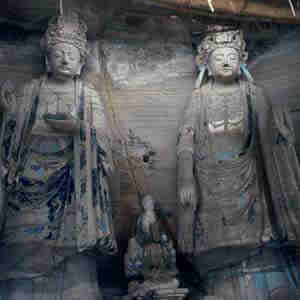Anyue: A Road To Stone Wonders
Updated: 2007-09-03 08:59
Anyue, an almost unknown little county to most people, lies serenely in Southwest China's Sichuan Province. However, to travelers from home and abroad, Anyue is so impressive that they cannot tear themselves away from it. It boasts an infinite treasure trove of splendid stone sculptures, which "carries on the Dunhuang legacy and enlightens the Dazu style," holding an important place in Chinese art history.

Hometown of stone sculptures
Anyue County, located in the middle between Southwest China's Chongqing Municipality and Chengdu City of Sichuan Province, woul be just a simple little town if not for its stone sculptures, which are ancient, abundant, and exquisite, scattered in the county's four corners.
Starting from 521 in the Southern Dynasty (420-589) through the Tang (618-907), Song (960-1279), Yuan (1271-1368), Ming (1368-1644), and Qing (1644-1911) dynasties, up to the Republic of China (1912-1949), Anyue grottos have had a history of about 1,500 years, with construction reaching the peak during the Song Dynasty. Today, boasting more than 200 grottos that houses over 100,000 Buddhist statues and sutras of about 400,000 words, Anyue is reputed as "the hometown of Chinese folk arts."
It is best to visit Anyue in the afternoon, when, after half of the day's busy work, the simple and unsophisticated little town is gradually unfolded before you: The locals sit by twos and threes in front of the bungalows, chatting or just resting. The peddlers with shoulder poles or barrows come out onto the alleys with yo-heave-hos rising and falling. Set off by the setting sun, the town is so peaceful, serene, and warm.
Yuanjue Cave
Yuanjue Cave, located on Mount Yunju one kilometer southeast of the county seat, is the first attraction in the trip.
The cave was created in the Tang Dynasty and flourished in the period of the Five Dynasties (907-960) and the Song Dynasty. Four hundred years of work left behind 103 niche-grottos with 1,933 statues of various sizes and 25 stele inscriptions as well as one Tang Dynasty pagoda.
The southern slopes of Mount Yunju contain sculptures from the Tang Dynasty and the Five Dynasties, depicting scenes from the "Buddhist Hell," "Sixteen Arhats," "Thousand Buddhas," and "Guanyin" (the Goddess of Mercy), and so on.

